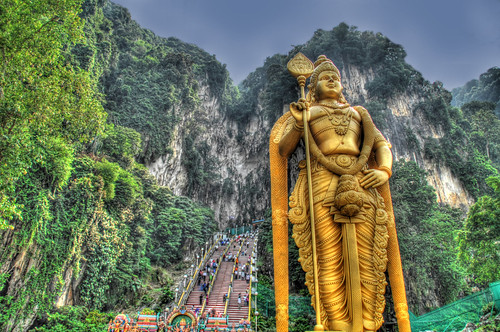The references to Murugan in Sanskrit literature can thus be traced back to the first millennium BCE. There are references to Subrahmanya in Kautilya's Arthashastra, in the works of Patanjali, in Kalidasa's epic poem the Kumarasambhavam and in the Sanskrit drama Mricchakatika. The Kushanas, who governed from what is today Peshawar, and the Yaudheyas, a republican clan in the Punjab, stuck coins bearing the image of Skanda. The deity was venerated also by the Iskhvakus, an Andhra dynasty, and the Guptas.
Sati, the consort of Shiva immolated herself at the Daksha Yagna, which was later destroyed by Shiva. Sati was reborn as Uma, or Parvati the daughter of the mountain king Himavaan (the Himalayas). Shiva withdrew himself from the universe and engaged himself in yogic meditation in the Himalayas.
In the meanwhile, the demon Surapadman ravaged the earth and tormented its beings. It was realized by the gods that only the son born of Shiva could lead the gods to victory over Tarakasuran, Surapadman and their demon companions. They plotted with Kamadeva, to shoot a flower arrow at Shiva, as he sat in meditation, so as to make him fall in love with Parvati. When Kama aimed his arrow, Shiva opened his third eye and burned Kama to ashes instantly.
The sparks of the fiery seed of Shiva were unbearable; even the fire God Agni could not bear them; this fire was then transported by the river Ganga into the Saravana forest into a pond called the Saravana Poigai(located at mouths of river Ganga), where the sparks became six children. They were raised by the six Krittika or Kartika - the stars that make up the Pleiades, earning the name Karthikeya. Parvati combined these six babies into one with six faces, ie. Shanmukha. Since he was born in the Saravana he was also called 'Saravanabhava.'
Murugan became the supreme general of the demi-gods then escorted the devas and led the army of the devas to victory against the demons. The six sites at which Karthikeya sojourned while leading his armies against Surapadman are Tiruttanikai, Swamimalai, Tiruvavinankudi (Palani), Pazhamudirsolai, Tirupparamkunram and Tiruchendur. All these sites have ancient temples glorified by the Tamil poems of Tirumurugaatruppadai of the Sangam period (circa the 3rd century CE).
http://en.wikipedia.org/wiki/Lord_Murugan














No hay comentarios:
Publicar un comentario